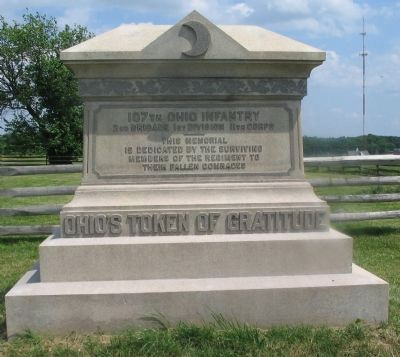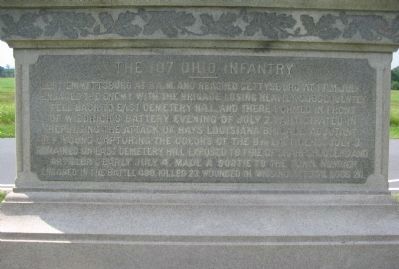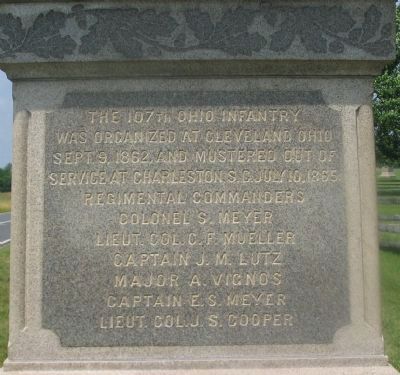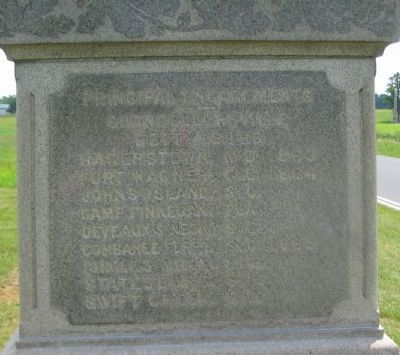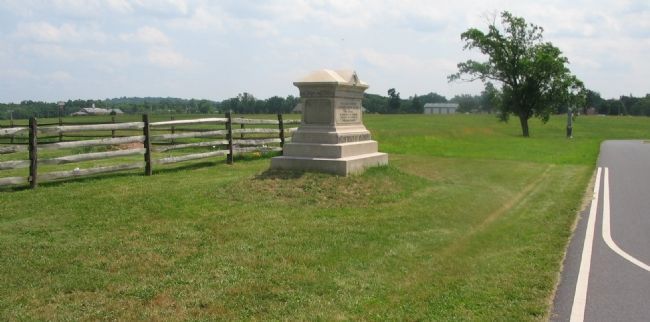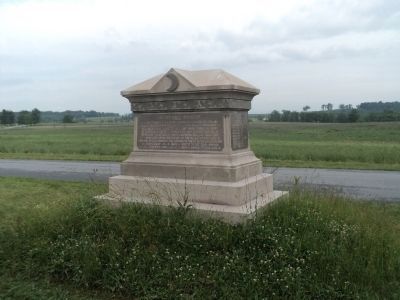Cumberland Township near Gettysburg in Adams County, Pennsylvania — The American Northeast (Mid-Atlantic)
107th Ohio Infantry
Ohio's Token of Gratitude
2nd Brigade 1st Division 11th Corps
This memorial
is dedicated by the surviving
members of the regiment to
their fallen comrades
Ohio's Token of Gratitude
(Back):
(Left):The 107th Ohio Infantry was organized at Cleveland, Ohio, Sept. 9, 1862 and mustered out of service at Charleston S.C. July 10, 1865. Regimental commanders: Colonel Meyer, Lieut. Col. C. F. Yueller, Captain J.M. Lutz, Major A. Vignos, Captain E. S. Meyer, Lieut. Col. J.S. Cooper.
(Right):
Chancellorsville
Gettysburg
Hagerstown, Md. 1863
Fort Wagner, S.C. 1864
John's Island, S.C.
Camp Finnegan, Fla.
Devereaux's Neck, S.C.
Combahee Ferry, S.C., 1865
Dingle's Mills, S.C.
Statesburo, S.C.
Swift Creek, S.C.
Erected 1887 by State of Ohio.
Topics. This memorial is listed in this topic list: War, US Civil. A significant historical year for this entry is 1862.
Location. 39° 50.676′ N, 77° 13.651′ W. Marker is near Gettysburg, Pennsylvania, in Adams County. It is in Cumberland Township. Memorial is on Howard Avenue, half a mile east of Carlisle Road (Pennsylvania Highway 34), on the right when traveling east. Located in Gettysburg National Military Park. Touch for map. Marker is in this post office area: Gettysburg PA 17325, United States of America. Touch for directions.
Other nearby markers. At least 8 other markers are within walking distance of this marker. Second Brigade (within shouting distance of this marker); First Division (within shouting distance of this marker); Gordon's Brigade (about 300 feet away, measured in a direct line); 58th New York Infantry (about 300 feet away); 25th and 75th Ohio Infantry (about 400 feet away); Driven Back (about 400 feet away); Francis Channing Barlow (about 400 feet away); 17th Connecticut Volunteers (about 500 feet away). Touch for a list and map of all markers in Gettysburg.
Also see . . .
1. 107th Ohio Infantry. Ohio Civil War website entry:
Service history of the regiment. (Submitted on September 9, 2008, by Craig Swain of Leesburg, Virginia.)
2. The Hard Luck Regiment of the 107th Ohio Infantry. History Net website entry (Submitted on August 31, 2022, by Larry Gertner of New York, New York.)
Additional commentary.
1. Dedication of the 107th OVI Monument at Barlow's Knoll, Gettysburg, Pa., Wednesday Afternoon, Septem
Star & Sentinel
Gettysburg, PA., Tuesday Evening, November 1, 1887
Memorial Address
----------------------
Delivered by Comrade A. J. Rider, of Navarre, Ohio,
at the Dedication of the 107th OVI Monument at Barlow's Knoll, Gettysburg, Pa.,
Wednesday Afternoon, September 14th, 1887.
----------------------
Comrades, Ladies, and Gentlemen: - You have assembled here on this autumnal day to pay a tribute of respect to the dead. Philanthropy, patriotism, and courage have been regarded as noble qualities, and when guided by prudence and wisdom, make good citizens. Persons possessing all these in a large or high degree, never fail to become benefactors of the race. But I wish to call your attention to another quality of mind which has never been held as the noblest and is always exercised relative to the source from whence benefits are derived. When Deity is the object, reverence is the feeling and worship its tribute. When benefactors are the objects, gratitude is the feeling and gifts, celebrations, monuments and care the objects it bestows. Your Pilgrimage hither to participate in these exercises is prompted mainly by gratitude, and the same feeling has induced our beloved State to contribute nineteen beautiful monuments to this field in care of that patriotic and philanthropic organization known as the Gettysburg Battlefield Memorial Association. These structures of beauty, magnificence and expense, especially the 107th which is dedicated to our fallen comrades, who were brave in life, noble and heroic in death, are placed here for the unremitting study of mankind and consecrated to the perpetual use of the study of history, for the perpetuity of the Union.
The origin of the project that convenes us here today, associates itself with scenes and incidents connected with the early history of this country, from the sailing of Columbus, and the landing of Ponce De Leon in Florida, to Plymouth Rock and the Mayflower. Search the records of that vessel over which waved the words “A State without a King” and compare the language of the Pilgrims before landing with the business of this occasion. Yet before they landed, the manner in which their government should be constituted was considered, and as some were observed not well affected to unity and concord; they formed themselves into a body politic, by a solemn and voluntary compact. Yet before we die, we dedicate this monument to our fallen comrades, the cause of liberty and the Union, and charge the living to preserve that Constitution they died to defend, the centennial anniversary of which is now being celebrated in Philadelphia. That compact for liberty of conscience, was celebrated by the dedication of the highest monument in the world, at Washington, to commemorate the valorous deeds of our forefathers on many a hard contested field, and here my comrades, in 1863, the pivotal battle for the Union, you assisted in forging the golden links that connected the hearts of our people, by the mystic chords of memory, and made the erection of that structure possible. Washington: to delineate fully and clearly the virtues of this great and good man, would require and angel’s pen, dipped in ethereal fire and an angel’s hand to guide it. His life cannot be too often reviewed; his example cannot be too closely imitated; like some magnificent scene of nature, his history is “ever charming ever new, the prospect never tires the view.” What has been said of the Father of his Country, is equally true of its preserver, Abraham Lincoln. This name stands associated with every amiable and noble quality, that man can attain. A sacred halo encircles it, that renders it dear to every philanthropist in the civilized
world. The first great act of Lincoln, was to raise the National emblem on Independence Hall, in Philadelphia; having done this, he went to the capitol of the Keystone State, where he again flung to the breeze our Star Spangled Banner, after which he proceeded to Washington and was inaugurated. After the flag had been fired on and the fall of Fort Sumter, the President issued calls for volunteers to maintain the authority and integrity of the Nation and in response to the 300,000 call of 1862, the 107th was mustered into service at Cleveland, Ohio, Sept. 9th. Soon after when Cincinnati was threatened by Kirby Smith, the regiment was sent to Camp Judah, Kentucky, from there to Camp Delaware, O., from thence to Washington, D.C., encamping on Arlington Heights, and assisting in constructing fortifications. After which it marched to Fairfax C.H. and was assigned to the 3rd Division (Carl Schurz) 11th Army Corp under command of Gen. Segel, soon after, it went to Stafford C.H., via Dumfries, and was assigned to the 2nd Brigade, 1st Division, 11th Corp. Participated in Burnside’s second campaign, Jan. 20th to 29th, 1863; afterwards did duty at Brooke’s Station, Va. From thence crossed the Rappahannock and Rapidan, and participated in the battle of Chancellorsville. We then returned to Brooke’s Station, and from thence in the Penna campaign to Bristoe Station, Centerville, crossing the Potomac at Williamsport, then on to Point of Rocks, Frederick, Middletown and Emmitsburg. July 1st, regiment left Emmitsburg at 8 o’clock, a.m., arriving here with Barlow’s Division, Ames’ Brigade, at 1 o’clock p.m.
The 25th, 75th and 107th Ohio, and 17th Connecticut regiments composed the Brigade, and were soon engaged with the enemy at this point, the 107th losing heavily. Subsequently the Brigade fell back to East Cemetery Hill, where the regiment formed in front of Wiedrich’s Battery. On the second it shared in receiving and repulsing the twilight charge of Hays’ Louisiana Brigade, Adjutant P. F. Young captured the colors of the 8th Louisiana Tigers.
During July 3rd, the regiment remained in position exposed to the fire of sharpshooters and artillery. Early on the 4th it made a sortie to the town capturing a number of prisoners. According to official record, the 107th entered this battle with 480 men, and lost therein, in killed, wounded and missing a total of 211. God in His infinite wisdom prepared the field of Gettysburg before the sailing of Columbus or the landing of the Pilgrims; a glance at our great civilization reveals the fact, that Gen. Hooker – a Californian – by resigning the command of the Army of the Potomac, opened the Castillian gate to Gen. Meade, who was born in Madrid, Spain. Hence, the same Providence that originated this government, directed the movements for its preservation, nature pointed out the tenable positions and all that was needed was to occupy and if possible hold them. During the three days fight, both armies did their best, cannon to cannon, musket to musket, and man to man, the question was decided and the superb fighting of the Army of the Potomac won the victory. At the critical juncture, July 1st, the 11th Corps like Gen. Meade came to the assistance of the 1st Corps, and by the prudent forethought and wise generalship of Gen. Howard, after the death of the gallant Gen. Reynolds, Steinwehr’s Division was placed on the heights and the tide of the first day was stayed and ever afterward broken on Cemetery Hill. The 11th Corps was composed largely of Germans and the 107th enlisted to “fight mit ‘Sigle,” their love of liberty brought them here, and the enemy soon learned that the same spirit that moved grand old Count Pulaski in the revolutionary struggle still inspired the soldiers in the 11th Corps.
On Sunday, July 5th, the regiment joined in the pursuit of Lee Potomac-ward. At Middletown, Md., the Army was then concentrated, passing through Funkstown and Boonsboro, the regiment was in action with the 1st Division, 11th Corp, at Hagerstown. Crossed the Potomac at Berlin, marched via Aldie to Warrenton Junction, Va. Here the division was ordered to join the forces of Gen. Gilmore in South Carolina. Aug. 9th, we left Alexandria on U. S. transports for Hilton Head.
After arriving with the division in the Department of the South the 107th first encamped on Morris and Folly Islands, assisting in the capture of Fort Wagner and Battery Gregg. During the Siege of Charleston, it lay a long time encamped alternately on Folly and Cole’s Islands. Was with Gen. Ames in the expedition to Seabrook, Klowa, and John’s Island to cut the Charleston and Savannah Railroad and in the engagement on John’s Island, Feb. 23rd, 1864, the 107th forming then a part of Gordon’s Division, left Folly Island on steamer with the Division for Jacksonville, Florida, to reinforce Gen. Seymour who after the battle of Olustee was sorely pressed by the enemy. Soon after Gen. Grant began to grapple with Lee in dead earnest and the Rebel and Union forces, were nearly all withdrawn to Virginia, about 3,000 men were left on our side, the 107th remained doing duty in east Florida, at Jacksonville, Fernandina and Fort Clinch. Frequently expeditions were made from these points, in one of which the Rebel Camp Finnegan was taken. In another Jackson O’Murray’s band of guerillas were captured and after trial by a military commission their leader was hung by the 107th at Jacksonville. Jackson O’Murray was hung because he hanged John Whitney, an innocent farmer, for having a copy of Sherman’s amnesty proclamation in his pocket.
Considering the number of men in these movements, as much relatively was achieved by them as by the grander operations of large bodies of troops. While en route to Fernandina, the regiment had to wait 24 hours at the mouth of St. John’s river, for high tide. In the evening we disembarked and camped on the historic spot where Ponce De Leon landed, Palm Sunday, April 2, 1512. In December, 1864, the regiment left Jacksonville for Hilton Head, S. C., on the steamer Delaware, to join the expedition of Gen. John P. Hatch, up the Broad river. The object of this expedition being to destroy the Charleston and Savannah Railroad and to co-operate with the forces of Gen. Sherman who was the advancing on Savannah, in their movements towards Charleston. Arriving at Devaux’s Neck we marched to the front which was a half a mile from the Railroad which the enemy used as breast-works. Gen. Hatch and Potter’s commands were about six thousand strong and continually harassed the enemy by shelling their trains and camp until December 29th, date of engagement at Devaux’s Neck. Sherman, having taken Savannah, Wheeler retreated with Hardee and Sherman marched pasted us to Pocotaligo. Forty-three Ohio regiments, history says participated in “Sherman’s March to the Sea.” Soon after our command marched via Pocotaligo to Gardner’s Corners, Sherman pushed forward to Cambahee Ferry, we were then on the right wing of Sherman’s army en route to Charleston. Feb. 5th, 1865 engagement at Cumbahee Ferry, night march and flank movement on Salkahatchie, thus compelling the enemy to retreat. So one movement after another; Feb. 18th, Charleston fell, and on the 22nd, Washington’s birthday, we captured Forts Washington and Beauregard near Rantowles, our band playing the national airs in Fort Washington at 12 o’clock p.m., while a national salute was being fired in Charleston. We then marched to the Lowndes plantation, near which is the family burying ground of Col. Wm. Washington of revolutionary fame. On this march the command captured about sixteen pieces of artillery. It then went to Charleston; the 107th band was the first to play in that city after its fall; serenaded Gen, Hatch, who was in command, staid over night, left next day on cars to Goose Creek. From thence we marched to Monk’s Corner, where Gen. Francis Marion used to operate. Here we waded water up to our chins, 25th Ohio in the lead, 107th next, Wheeler’s men in front with artillery in the road near the old stone church. A part of his artillery was captured and the enemy retreated. After pushing the Confederates across the Santee River, Potter’s Division, which we had joined, returned to Charelston. On this raid we saw the efficacy of the “old flag.” The enemy as well as our troops destroyed everything, an old planter came riding up and inquired for the General’s headquarters, he soon returned with an orderly and a Union flag, and as we passed by his plantation the “old flag” waved from an upstairs window and his house was saved. The same flag was then ahead to the next plantation and by its presence a number of residences were saved from destruction or injury. Returned to Charleston from Calias on tin clad to steamer Croton, thence to city. Left next day on the double ender man-of-war, Sonoma, for historic Georgetown. At this place I came into possession of a neatly prepared copy of South Carolina’s Odrinance of Secession, bearing the names of 170 signers, the “Bonnie Blue Flag” inscribed thereon, a Palmetto Tree and a Turkish crescent. To the members of the 11th Corps the crescent is significant, while the palmetto crescent in its would-be national association has passed into oblivion, the 11th Corps badge is perpetual on our monuments. From Georgetown the regiment pushed rapidly forward with Potter’s Division into the interior via Kingstree, Dingle’s Mill, and Sumterville, thence to Statesburg, Camden, Swift Creek, and Singleton’s plantation; in these engagements defeating the enemy at every point. Having performed the mission on which they had been sent, viz: The destruction of all the rolling stock on the railroads in this vicinity, the command was on its way back to the coast, April 25th, when Gen. Potter received a flag of truce from the enemy requesting a cessation of hostilities on account of the surrender of Lee to Gen. Grant at Appomattox C. H.
April 9th, our boys went wild with gladness. The scene on ex-Gov. Manning’s plantation was one never to be forgotten, to us it meant the end of marches, battles and all that was disagreeable in the life of a soldier. To us as lovers of human liberty and popular government it meant the freedom of near four million slaves and the preservation of the United States against the most powerful forced ever arrayed against it. The command returned to Georgetown and soon after, the 107th by steamer to Charleston, where it did provost duty under Gen. Hatch until July 10th, 1865, when it was mustered out, and immediately left on steamer Salver for New York, arriving at Cleveland, Ohio, on the 18th, and met with a grand reception, was paid off and finally discharged July 25th, just three years from date of organization. Aggregate strength of the regiment during its term of service 1080. Aggregate loss in killed, wounded and missing 580.
In conclusion, let us return to South Carolina, where the victorious eagle spread his balmy wings in proud security, and note a few of the closing scenes of the rebellion.
On the 13th day of April, 1865, Major Anderson, the hero of Fort Sumter, amid the boom of cannon, fired by all the forts and gun boats at Charleston, hoisted the same dear old national flag, which he had been compelled to take down four years previously. Scarcely had the echoes of those guns died away, when a boat from the north brought the glad tidings of Lee’s surrender, in honor of which, another salute of one hundred guns was fired at four o’clock p.m., another boat conveyed the sad news that President Lincoln had been assassinated; and thus amid rejoicings came sadness and sorrow, the soul that had taken all the people into its care had gone to its reward; the great heart that would not willingly plant a thorn in any man’s bosom, was stilled in death “by the red band of murder.” “With malice toward none, with charity for all,” his heart cherished a desire for a just and lasting peace among ourselves and all nations. The clock of eternity has stricken twenty-two since those scenes were enacted, and twenty-four since the immortal Lincoln delivered the address of dedication in the National Cemetery on yonder hill. “These dead have not died in vain,” the Nation’s gratitude has generously procured 79 cemeteries in which repose 300,000 comrades who gave their lives for the preservation of the Union. Monuments to the memory of the soldiers are being erected all over the land. Ohio has kindly remembered her sons, with appropriate mementoes, and these monuments are object lessons, in the history of our country, and are of priceless value to the youth of the land. The sentiments expressed by Washington, in the epitaph on the tomb of Baron De Kalb at Camden, S. C., commemorating his gallant behavior and glorious death, while commanding the Continentals, seems fittingly appropriate for our departed comrades of the 11th Corps on this field. The legend is gratefully descriptive of his virtues and services, that the people of future days may read of the generous stranger, who came from a distant land, to fight their battles, and to water with his blood, the tree of their liberties.
“Fair Camden’s plains his glorious dust inhume,
Where annual Ceres shades her hero’s tomb.”
A word for Ohio and the old Flag and I am done. Ohio troops fought at Pea Ridge, they charged at Wagner, they helped redeem Florida, South and North Carolina, they were in the siege of Vicksburg, Charleston, Mobile and Richmond. At Pittsburg Landing, Antietam, Chancellorsville, Gettysburg and Corinth. In the Wilderness, Five Forks, before Nashville and Appomattox Court House; their bones reposing on the fields they won, and in the graves they fill, are a perpetual pledge, that no flag shall ever wave over their graves, but that flag they died to maintain, - So long as that flag shall bear aloft its glittering stars, flaunting them amidst the din of battle, and waving them triumphantly above the storms of the ocean, so long I trust, shall the rights of American citizens be preserved safe and unimpaired, and transmitted as a sacred legacy from one generation to another, till discord shall wreck the spheres, the grand march of time shall cease, and not one fragment of all creation be left to chafe on the bosom of eternity’s waves. Note To Editor only visible by Contributor and editor
— Submitted June 8, 2013, by Bryan Baker of Berryville, Arkansas.
Credits. This page was last revised on February 7, 2023. It was originally submitted on September 9, 2008, by Craig Swain of Leesburg, Virginia. This page has been viewed 3,619 times since then and 48 times this year. Last updated on November 17, 2012, by Cynthia Vignos of Canton, Ohio. Photos: 1, 2, 3, 4, 5. submitted on September 9, 2008, by Craig Swain of Leesburg, Virginia. 6. submitted on June 9, 2013, by Bill Coughlin of Woodland Park, New Jersey.
